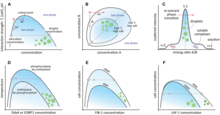Coacervate
These structures draw a lot of interest because they form spontaneously from aqueous mixtures and provide stable compartmentalization without the need of a membrane—they are protocell candidates.
The term coacervate was coined in 1929 by Dutch chemist Hendrik G. Bungenberg de Jong and Hugo R. Kruyt while studying lyophilic colloidal dispersions.
The concept was later borrowed by Russian biologist Alexander I. Oparin to describe the proteinoid microspheres proposed to be primitive cells (protocells) on early Earth.
[3][4] A few years later in 2009 the role of liquid-liquid phase separation was further recognized to be involved in the formation of certain membraneless organelles by the biophysicists Clifford Brangwynne and Tony Hyman.
[6][7] Coacervates are a type of lyophilic colloid; that is, the dense phase retains some of the original solvent – generally water – and does not collapse into solid aggregates, rather keeping a liquid property.
In non-ideal solutions, ΔmixH can be different from zero, and the process endothermic enough to overcome the entropic term and favor the de-mixed state (the blue curve shifts up).
The conditions of the mixture in comparison to the two curves defines the phase separation mechanism: nucleation-growth of coacervate droplets (when the binodal region is crossed slowly) and spinodal decomposition.
The Voorn-Overbeek approach applies the Debye-Hückel approximation to the enthalpic term in the Flory-Huggins model, and considers two polyelectrolytes of the same length and at the same concentration.
Unlike classic membrane-bound organelles (e.g. mitochondrion, nucleus or lysosome), MLOs are not separated from their surroundings by a lipid bilayer.
They have been shown to serve various functions: they can store and protect cellular material during stress conditions,[16] they participate in gene expression[17][18] and they are involved in the control of signal transduction.
[14] Many proteins participating in the formation of MLO contain so-called intrinsically disordered regions (IDRs), parts of the polypeptide chain that can adopt multiple secondary structures and form random coils in solution.
IDRs can provide interactions responsible for LLPS, but over time conformational changes (sometimes promoted by mutations or post-translational modifications) may lead to the formation of higher ordered structures and solidification of MLOs.
Several years later, in 1929, Bungenberg-de Jong published a seminal paper with his PhD advisor, H. R. Kruyt, entitled “Coacervation.
They term this phenomenon coacervation, derived from the prefix co and the Latin word acervus (heap), which relates to the dense liquid droplets.
In the meantime, Russian chemist Alexander Oparin, published a pioneering work in which he laid out his protocell theory on the origin of life.
[32] In his initial protocell model, Oparin took inspiration from Graham's description of colloids from 1861 as substances that usually give cloudy solutions and cannot pass through membranes.
Haldane used the term primordial soup to refer to the dilute mixture of organic molecules that could have built up as a result of reactions between inorganic building blocks such as ammonia, carbon dioxide and water, in presence of UV light as an energy source.
[35] Oparin proposed that simple building blocks with increasing complexity could organize locally, or self-assemble, to form protocells with living properties.
[36] He performed experiments based on Bungenberg de Jong's colloidal aggregates (coacervates) to encapsulate proteinoids and enzymes within protocells.
Work by chemists Sidney Fox, Kaoru Harada, Stanley Miller and Harold Urey further strengthened the theory that inorganic building blocks could increase in complexity and give rise to cell-like structures.
[37] The Oparin-Haldane hypothesis established the foundations of research on the chemistry of abiogenesis, but the lipid-world and RNA-world scenarios have gained more attention since the 1980s with the work of Morowitz, Luisi and Szostak.
However, recently, there has been a rising interest in coacervates as protocells, resonating with current findings that reactions too slow or unlikely in aqueous solutions can be significantly favored in such membraneless compartments.


